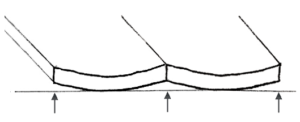When a once beautiful hardwood floor all of a sudden shows defects, changes in wood moisture are most likely the reason. Even small changes of moisture in hardwood floors can have a large impact, when hundreds of boards are laid side by side.
Common Causes for Moisture Problems
– Floor planks were not dry at the time of installation.
– Sub floor is too wet.
– Existing or new concrete slab is too wet.
– Water spills and leaks.
– Ambient conditions not right, see EMC Table.
Cracks between hardwood floor planks:
Even if the hardwood floor was installed properly and the floor planks were dry at the time of installation, some wood movement can occur when the relative humidity changes with the seasons. Floor planks may shrink and small cracks appear during the dry winter months with the heat is turned on. The cracks disappear during the wetter summer months. Controlling the relative humidity within the room will eliminate this problem.
Cupping:

The edges of the floor planks are pulled up and the center remains lower. This happens when the up-side of the floor planks loose moisture and shrink, but the down-side does not follow. It can also happen when the down-side of the floor absorbs moisture from the sub floor and expands. Cupping becomes very obvious when looking across a floor against the light. Minor cupping could be the result from seasonal changes of relative humidity.
Often the floor will reabsorb moisture again and flatten out. If the problem is more severe and resanding is considered, be careful. Sanding will leave the edges on the down-side of the floor planks unsupported.
Crowning:
The center of the floor planks is higher and the edges lower. This happens when the up-side of the floor planks absorb moisture and expand. Be careful when sanding, because the middle on the down-side of the floor planks will be unsupported.
Buckling:
Extreme crowning lifts the floor planks several inches off the sub floor. This is usually caused by a water leak or flood.
If you are not always present, Lignomat’s remote warning systems can keep track of changes in relative humidity, temperature and wood moisture. Measured values are accessible over the Internet.
Is there a cure for hardwood floors with moisture problems? Minor problems may be caused by seasonal changes. The defects come and go with summer-winter changes. This can only be avoided by operating an HVAC year around. For more severe moisture problems, expensive repair work or replacement may be necessary. Drying out and resanding may help. If the defects are so severe that the structure of the hardwood has been damaged or the wood is permanently distorted there is no cure. The hardwood floor has to be replaced.

As supplier, contractor and floor installer it is important to follow NWFA guidelines and manufacturer’s instructions. Take moisture measurements and keep records – important steps in protecting yourself from unwarranted claims.
Then, nobody wants to take the blame:
The homeowner turning the air condition off. The floor supplier delivering wet wood. The contractor / sub-contractor / installer not checking the concrete slab or the sub floor, not acclimating the floor long enough, not installing the floor properly.
Before installing a hardwood floor, the floor planks, subfloor and concrete slab should be checked. The ambient conditions (relative humidity and temperature) during acclimation of the floor planks and during installation should be the same as later on, when the floor is in use.
Following manufacturer’s instructions and NWFA guidelines, keeping note of measurements can help later-on if problems occur.

When you have finished installing a floor, take a picture of a moisture meter measurement with a “landmark” in it. Later, in case you have to come back to check out a problem, you have a reference location and a reference moisture content value. If you want to be sure, that a customer’s floor is not changing its moisture content, you can install a wireless monitoring system or aBL2 Moisture Tracker.

Use EMC Table and photo of shrinking white oak to explain to your customers, how much the ambient conditions inside his home determine the behavior of the wood floor.
Check out the unique dual-depth pinless moisture meter ideal for the floor installer:
Ligno-Scanner SD dual-depth 1/4″ and 3/4″
Ligno-DuoTecBW dual-depth 1/4″ and 3/4″ with RH capabilities
Ligno-VersaTec dual-depth 1/4″ and 3/4″ with RH and pin capabilities
→Click here for Floor Report
→Click here for article in FCI Magazine: How Humidity affects Wood

